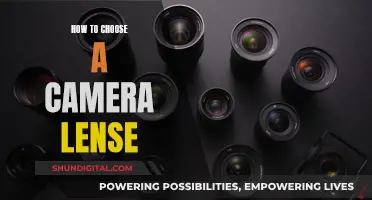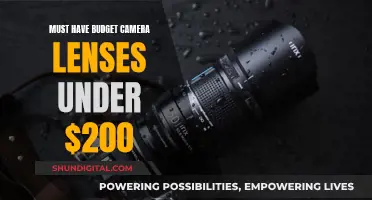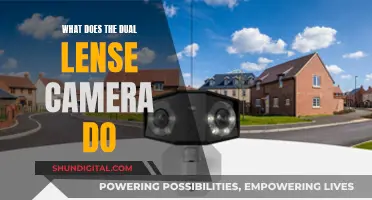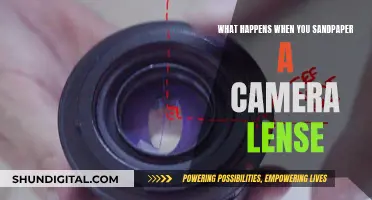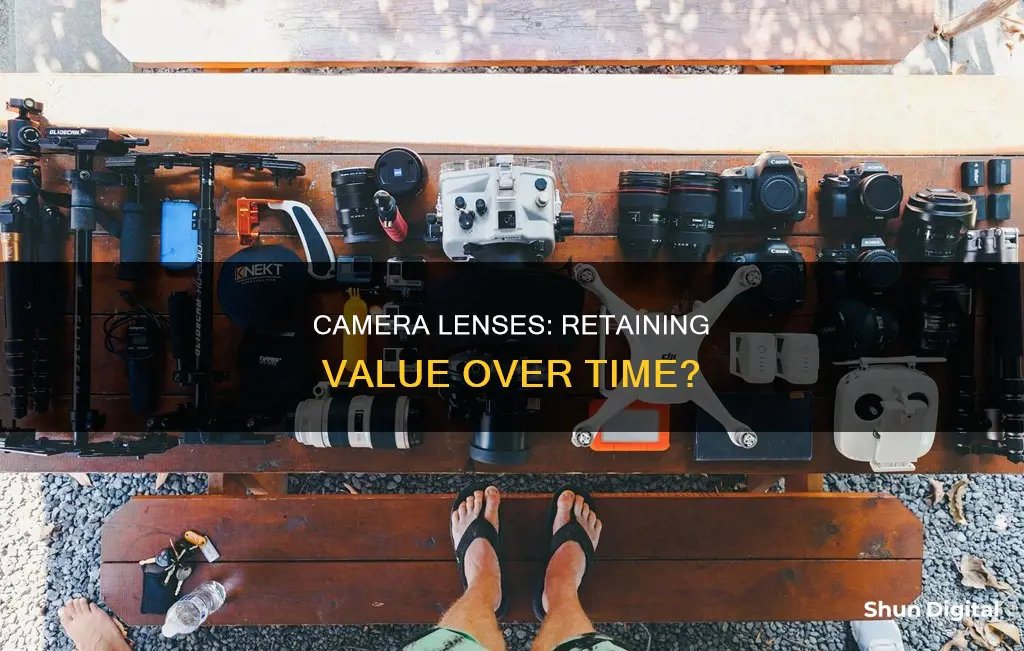
Camera lenses can hold their value, but it depends on the type of lens, its age, and the demand for it. Prime lenses, for example, have historically been seen as better optically, with wider apertures, and more durable than zoom lenses. However, advancements in technology have blurred these lines, and now zoom lenses can offer great optical performance and wide apertures, albeit at the cost of size and weight.
Another factor that affects the value of a lens is its mount type. Lenses with mounts that have been discontinued by the manufacturer, such as the Alpha-mount lenses by Sony, tend to depreciate faster. Additionally, lenses that lack autofocus ability or are from defunct manufacturers may also lose value over time.
When it comes to determining the resale value of a lens, it is important to consider factors such as the lens's age, condition, and comparable prices for similar used lenses on the market. Websites like eBay, Craigslist, and specialist camera shops can provide insights into the market value of used lenses. It is worth noting that private sales through online groups or classifieds may yield different prices than sales through camera shops or dealers, who typically apply a markup to cover warranties and returns.
While lenses can hold their value, it is important to remember that the value may decrease over time, especially with newer models entering the market. Therefore, those looking to sell their lenses should consider the balance between selling for the ideal price and making a quick sale, as prices may continue to drop over time.
What You'll Learn

Prime lenses are more expensive but hold their value better
Camera lenses can be expensive, and it is important to consider whether they hold their value over time. Prime lenses are generally more expensive than zoom lenses, but they also tend to hold their value better.
Prime lenses have a fixed focal length, meaning the photographer must physically move closer or farther away from the subject to change how big or small they appear in the frame. While this may be less convenient than the variable focal length offered by zoom lenses, prime lenses make up for this with their compact size and wide aperture, which allows for better performance in low-light conditions and easier background blurring.
The average buy price for a prime lens is $637, compared to $340 for a zoom lens. Over the last three years, prime lenses have increased in price by 11%, while zoom lenses have decreased by 1%. This trend is also reflected in the average sell price, with zooms decreasing by 1% and primes increasing by 15%.
The higher price of prime lenses can be attributed to factors such as the use of high-quality metal, tight engineering tolerances, and the need for precise craftsmanship. Cinema prime lenses, for example, are handmade and designed to meet the demanding requirements of the film industry, such as producing high-quality images that can be projected onto large screens.
When it comes to investing in camera lenses, it is worth considering both modern and vintage options. Vintage lenses, often made for older film cameras, can offer unique artistic effects at a more affordable price. They may also be a good option for those who want to practice manual focusing. However, modern lenses offer improved optical performance and convenience features such as autofocus and image stabilisation, which can be important for certain types of photography or video work.
Overall, while prime lenses come with a higher price tag, their ability to hold their value over time may make them a more financially savvy investment for photographers and filmmakers.
Infinity Focus: Are Camera Lenses Capable?
You may want to see also

Zoom lenses are bigger and heavier but sacrifice size and weight
Yes, camera lenses hold their value over time. In fact, some lenses may even increase in value, especially if they are limited edition or are no longer in production. This is because lenses are not subject to the same rapid technological advancements as camera bodies, so they remain useful and sought-after for longer. Additionally, lenses are built to last and are often made with high-quality glass and metals, which contributes to their durability and longevity.
However, it is important to note that not all lenses hold their value equally. The value retention of a lens can depend on various factors, including the brand, model, condition, and age of the lens. For example, lenses from well-known brands like Canon or Nikon may hold their value better than lesser-known brands. Lenses that are in high demand, such as those with unique features or those that are compatible with multiple camera systems, may also retain their value more effectively.
Ultimately, if you are looking to invest in a lens, it is important to do your research and consider the potential resale value, especially if you plan on upgrading or selling your equipment in the future.
Author: VariousZoom lenses offer photographers the ability to capture a wide range of focal lengths with a single lens, making them incredibly versatile. However, this versatility comes at a cost, as zoom lenses tend to be bigger and heavier than their prime lens counterparts.
One of the main reasons zoom lenses are larger and heavier is because they are typically designed to cover a much wider range of focal distances. This requires more internal lenses and moving parts, which adds to the overall size and weight of the lens. Additionally, zoom lenses often have larger maximum apertures, which require larger front elements, further contributing to their bulkiness.
Another factor that affects the size and weight of zoom lenses is the sensor size they are designed for. Lenses designed for cameras with larger sensors, such as DSLRs or mirrorless cameras, tend to be bigger and heavier than those designed for cameras with smaller sensors. This is because the lens has to project a larger image circle to cover the larger sensor.
It is also worth noting that the size and weight of zoom lenses can vary depending on the specific type of zoom lens. For example, superzoom lenses, which offer an extremely wide range of focal lengths, tend to be heavier and bulkier than standard zoom lenses. On the other hand, wide-angle zoom lenses, which are designed to capture very large areas, tend to be more compact and lightweight.
While zoom lenses offer unparalleled versatility and convenience, their bigger and heavier form factor is a trade-off that photographers must consider. For those seeking a more portable option, prime lenses might be a better choice, as they cover a single focal length and tend to be smaller and lighter. Nonetheless, for photographers who prioritise flexibility and the ability to quickly adjust their focal length, zoom lenses remain a valuable and indispensable tool, despite their larger size and weight.
Radioactive Camera Lenses: Are They Safe to Use?
You may want to see also

Vintage lenses are cheaper and can create a unique, artsy look
Vintage lenses are a great option for photographers looking to create a unique, artsy look with their images. These lenses, which date back to the film era, often have manual focus and aperture controls, allowing for more creative experimentation. Their optical characteristics, such as lens coatings, the number of lens elements, and aperture blades, can produce more pronounced lens flares, softer images, chromatic aberration, and distinctive bokeh effects. This gives your photos a timeless, vintage look that stands out from the crowd and adds a certain "Je ne sais quoi".
Vintage lenses are also usually more affordable than their modern counterparts, making them a budget-friendly option for photographers. Their lower prices also mean that you can experiment with different focal lengths and effects without breaking the bank. For example, the Helios 44-2 58mm f/2 Prime Lens, which is known for its swirly bokeh effect, can be found for around $50-60.
Additionally, vintage lenses often have a sturdy metal construction, making them more durable than modern plastic lenses. They are also readily adaptable to modern DSLR and mirrorless cameras with the help of inexpensive adapters.
Some popular vintage lenses to consider include:
- Canon FD 24mm f2.8 Wideangle Prime Lens
- Pentax Asahi Super-Takumar 35mm f/2 Prime Lens
- Canon FD 55mm f/1.2 S.S.C Prime Lens
- Helios 44-2 58mm f/2 Prime Lens
- Zenit Helios 40-2 85mm f/1.5 MC Prime Lens
- Voigtländer 35mm f2.5 VM Color-Skopar P II Lens
- Voigtländer 58mm F1.4 SLII-S Nokton
- Helios 44 58mm f2
- Petzval 80.5 mm f/1.9 MKII
- Canon FD 50mm f/1.4 SSC
- Minolta 50mm f/1.4
- Pentax Super Takumar 50mm f/1.4
So, if you're looking to add a unique, artsy touch to your photography, vintage lenses are definitely worth considering. Their affordable prices, distinctive characteristics, and adaptability make them a great choice for photographers wanting to explore a different style.
Vintage Camera Lenses: Worth the Money or Not?
You may want to see also

Cheaper lenses are a lower-risk investment
This is especially true if you are just starting out in photography. Inexpensive lenses allow you to experiment with different focal lengths and try out vintage lenses without breaking the bank. You can also buy multiple lenses to have in your camera bag at once, which is a much better use of your money than investing in one expensive lens.
Cheaper lenses are also more convenient to buy, as you can purchase them from a variety of locations, including retail stores, vision centres, and online shops.
When deciding which cheap lenses to buy, it is best to stick to those made by your camera brand, such as Canon, Nikon, or Sony. These will likely be compatible with both full-frame and crop-sensor cameras and will have better image quality than third-party lenses. Old prime lenses that still use a modern mounting system, like the Canon EF 100mm f/2 USM, are also a good option, as they offer great image quality at a lower price.
In addition, cheap lenses are usually smaller and more compact, making them easier to store and transport. This can be especially beneficial for street photographers, as a smaller lens is less intrusive and may make people act more naturally around you.
So, if you're looking to invest in some new camera lenses, consider starting with cheaper options. You can always sell them later if you decide to upgrade, and you'll likely get back a significant portion of your initial investment.
Bigger Camera Lenses: Do They Make a Difference?
You may want to see also

Camera bodies depreciate quickly
Camera bodies depreciate much faster than camera lenses. This is because most of the new features are loaded into the camera body, which leads to shorter production cycles. This means that the release of a new camera body model can be expected much sooner than a new lens model.
The more you use a camera body, the more its value depreciates. This is because the camera is one of the most used pieces of equipment in a photography studio. The high usage leads to a shorter lifespan.
The demand for Digital Single-Lens Reflex (DSLR) cameras is still high, which means that their value is depreciating at a slower rate than mirrorless cameras. Between 2018 and 2021, mirrorless cameras saw a 14.6% drop in value, while DSLRs only dropped by 11.1%.
The value of a camera body also depends on the brand. For example, between 2018 and 2021, Sony mirrorless bodies saw the least depreciation in average price ($586 in 2018 to $562 in 2021), with Canon ($321 in 2018 to $288 in 2021) and Fujifilm ($450 in 2018 to $403 in 2021) close behind.
Overall, camera bodies depreciate quickly due to frequent innovations in camera technology, high usage, and brand differences.
Camera Lenses: Are Their Filters Universal?
You may want to see also
Frequently asked questions
Yes, camera lenses tend to hold their value, especially when compared to camera bodies.
The value of a camera lens can be affected by its age, condition, brand, and whether it has been discontinued or replaced by a newer model.
You can check the resale value of a camera lens by looking at sold listings on websites like eBay or by comparing prices on used camera gear websites and in local camera shops.
It depends. Prime lenses tend to be more expensive and hold their value better than zoom lenses, but there are exceptions. For example, some zoom lenses from Canon and Tokina have increased in price over the years.
There are several ways to sell a camera lens, including online marketplaces like eBay or Craigslist, camera shops that sell used equipment, commission sales through a dealer, or local photography groups on Facebook.


